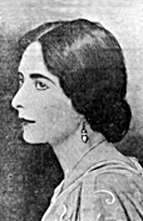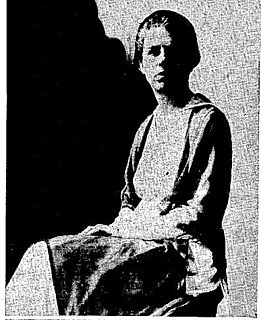
William Carlos Williams was an American poet, writer, and physician closely associated with modernism and imagism.

Imagism was a movement in early-20th-century Anglo-American poetry that favored precision of imagery and clear, sharp language. It gave modernism its first start, and is considered to be the first organized modernist literary movement in the English language. Imagism is sometimes viewed as "a succession of creative moments" rather than a continuous or sustained period of development. René Taupin remarked that "it is more accurate to consider Imagism not as a doctrine, nor even as a poetic school, but as the association of a few poets who were for a certain time in agreement on a small number of important principles".

Marianne Craig Moore was an American modernist poet, critic, translator, and editor. Her poetry is noted for formal innovation, precise diction, irony, and wit.
Modernist poetry in English started in the early years of the 20th century with the appearance of the Imagists. In common with many other modernists, these poets wrote in reaction to the perceived excesses of Victorian poetry, with its emphasis on traditional formalism and ornate diction. In many respects, their criticism echoes what William Wordsworth wrote in Preface to Lyrical Ballads to instigate the Romantic movement in British poetry over a century earlier, criticising the gauche and pompous school which then pervaded, and seeking to bring poetry to the layman.

Basil Cheesman Bunting was a British modernist poet whose reputation was established with the publication of Briggflatts in 1966, generally regarded as one of the major achievements of the modernist tradition in English. He had a lifelong interest in music that led him to emphasise the sonic qualities of poetry, particularly the importance of reading poetry aloud. He was an accomplished reader of his own work.

Mina Loy was a British-born artist, writer, poet, playwright, novelist, painter, designer of lamps, and bohemian. She was one of the last of the first-generation modernists to achieve posthumous recognition. Her poetry was admired by T. S. Eliot, Ezra Pound, William Carlos Williams, Basil Bunting, Gertrude Stein, Francis Picabia, and Yvor Winters, among others. As stated by Nicholas Fox Weber in the New York Times, "This brave soul had the courage and wit to be original. Mina Loy may never be more than a vaguely familiar name, a passing satellite, but at least she sparkled from an orbit of her own choosing."

Poetry has been published in Chicago since 1912. It is one of the leading monthly poetry journals in the English-speaking world. Founded by Harriet Monroe, it is now published by the Poetry Foundation. In 2007 the magazine had a circulation of 30,000, and printed 300 poems per year out of approximately 100,000 submissions. It is sometimes referred to as Poetry—Chicago.
The Dial was an American magazine published intermittently from 1840 to 1929. In its first form, from 1840 to 1844, it served as the chief publication of the Transcendentalists. From the 1880s to 1919 it was revived as a political review and literary criticism magazine. From 1920 to 1929 it was an influential outlet for modernist literature in English.

Helen Lyman commonly known as Helen Hoyt or Helen Hoyt Lyman was an American poet.

Alfred Francis Kreymborg was an American poet, novelist, playwright, literary editor and anthologist.

The Glebe was a literary magazine edited by Alfred Kreymborg and Man Ray from 1913 to 1914. The first issue was published from Grantwood, New Jersey while the rest of the run was published in New York by Albert & Charles Boni. Ten issues were produced, with a circulation of 300. Issue number 5 comprised the first anthology of Imagism: Des Imagistes.
The National Poetry Foundation (NPF) is a book publisher founded in 1971 by Carroll F. Terrell who built its reputation with Burton Hatlen at the University of Maine in Orono. Today it publishes poetry by individual authors as well as both journals and scholarship devoted to Ezra Pound and poets in the Imagist and "Objectivist" traditions. It has also positioned itself as a center and host for international conferences on modern poetry.
Nationality words link to articles with information on the nation's poetry or literature.
Nationality words link to articles with information on the nation's poetry or literature.
Allen Norton (1878?-1945?) was an American poet and literary editor of the 1910s and 20s. His father, E.L. Norton, was a stock broker. He went to Harvard, where he specialized in literature and began writing poetry. He and his wife Louise Norton edited the little magazine Rogue, published from March 1915 to December 1916. The periodical, partly financed by Walter Conrad Arensberg, served as an early showcase for the work of Arensberg himself, Wallace Stevens, Mina Loy, and Alfred Kreymborg. Norton's 1914 volume of verse, Saloon Sonnets With Sunday Flutings, was published by Donald Evan's Claire Marie Press. Heavily influenced by fin-de-siècle aestheticism, Alice Corbin Henderson remarked that his work, along with the poetry of Evans himself, represented something of a revival of that style. Poems in the volume included Impressions of Oscar Wilde, Modern Love and Mrs. Eddy: a Mask.
Cristanne Miller received her PhD in 1980 from the University of Chicago, and was for many years the W.M. Keck Distinguished Service Professor at Pomona College. Since 2006 she has taught at the University at Buffalo in New York, where she is SUNY Distinguished Professor and Edward H. Butler Professor of English.
Carolyn Burke is an Australian-born American translator, art critic, and author of four biographies. Her first was a life of the English poet Mina Loy, was published in 1996 and reprinted in 2021. She has also written books about the American photographer Lee Miller, the French chanteuse Edith Piaf, and the interwoven lives of four iconic figures of American art, Alfred Stieglitz, Georgia O’Keeffe, Paul Strand, and Rebecca Salsbury.

Grantwood is an community straddling the boroughs of Cliffside Park and Ridgefield, just south of Fort Lee, in eastern Bergen County, New Jersey, United States.
Feminist poetry is inspired by, promotes, or elaborates on feminist principles and ideas. It might be written with the conscious aim of expressing feminist principles, although sometimes it is identified as feminist by critics in a later era. Some writers are thought to express feminist ideas even if the writer was not an active member of the political movement during their era. Many feminist movements, however, have embraced poetry as a vehicle for communicating with public audiences through anthologies, poetry collections, and public readings.
Marjorie Allen Seiffert, was an American poet and winner of the 1919 Levinson Prize for Poetry. She used several pseudonyms over the course of her career, including Angela Cypher for some of her lighter verse and Elijah Hay for poems she wrote as part of the Spectrist hoax.










